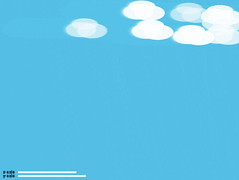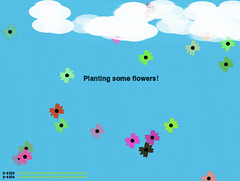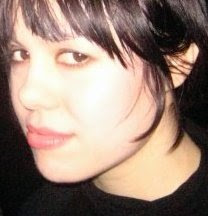Hey guys,
I have updated my Joan Dress blog, and have reached the end of phase 1 of the development process. Check it out!
Wednesday, April 25, 2007
Monday, April 23, 2007
Actions, Events, and Filtering
I wrote a program in processing that reacts to how vigorously you shake an accelerometer.
The arduino communicates the sensor's readings through a serial connection to processing. I used a smoothing function, in my arduino code, to get clean values from the accelerometer, which tends to give very eradict readings otherwise.
When you first open up the processing app, it is a calm, blue day.
If you make it so that the sensor's readings match up on the x- and y-axis, you plant flowers on the screen.
Slightly shaking it causes the blooms to blow...
Quickly shaking it causes a rain storm (and all the flowers blow away)
Leaving the sensor alone for 10 seconds let's the storm go away, returning you to a clear day.
Download Processing and Arduino code
The arduino communicates the sensor's readings through a serial connection to processing. I used a smoothing function, in my arduino code, to get clean values from the accelerometer, which tends to give very eradict readings otherwise.
When you first open up the processing app, it is a calm, blue day.
If you make it so that the sensor's readings match up on the x- and y-axis, you plant flowers on the screen.
Slightly shaking it causes the blooms to blow...
Quickly shaking it causes a rain storm (and all the flowers blow away)
Leaving the sensor alone for 10 seconds let's the storm go away, returning you to a clear day.
Download Processing and Arduino code
Monday, April 09, 2007
language objects
The Inkas may have used clusters of strings and knots (called khipu) as their way of recording language, while most other cultures of the world have used written records of ink on paper. This suggestion is described in 1491: New Revelations of the Americas Before Columbus by Charles C. Mann, Appendix B.
Honestly, I have never stopped to think about representing language in terms of objects versus written symbols, but the concept of creating a physical system for recording thoughts is actually quite inspiring. It reminds me of the way genes are encoded in long strands of DNA, although this system sounds like it has many more base elements to it. These elements include the kind of material used, the way the strings were spun, and the direction of the knots attached to all the other strings in the khipu. There were also, apparently, 24 different string colors.
It makes me think that it might be interesting to create a kind of khipu myself. The Inka's khipu sound fairly complex however; each khipu which has been found encoded one of 1,536 possible "distinct information units"!
Honestly, I have never stopped to think about representing language in terms of objects versus written symbols, but the concept of creating a physical system for recording thoughts is actually quite inspiring. It reminds me of the way genes are encoded in long strands of DNA, although this system sounds like it has many more base elements to it. These elements include the kind of material used, the way the strings were spun, and the direction of the knots attached to all the other strings in the khipu. There were also, apparently, 24 different string colors.
It makes me think that it might be interesting to create a kind of khipu myself. The Inka's khipu sound fairly complex however; each khipu which has been found encoded one of 1,536 possible "distinct information units"!
Our clothes have a fingerprint
I read this fascinating article the other week on how a robber was nabbed based on a unique pattern of wrinkles found down the side of his blue jeans, as seen on the bank's surveillance tape. The puckers and creases along the side-seam of his pants were a result of how his body moved within the denim fabric, thus creating a kind of barcode, or fingerprint, which was used as indisputable evidence in a court of law.
This made me think about all the ways in which we leave our own marks on our habitats. I love thinking about how our environments, including of course, our own bodies, act as a record of our lives. The kinds of activities we engage in, the way we move, these are all silently recorded, day by day. Just looking at my office chair, it's evident that i like to sit on my heels while in it; the fabric is stressed and slightly pushed downwards from the center of the seat.
This also made me think about the notion of 'memory'. It's not an original musing perhaps, but i still find memory fascinating. Life may seem to exist right here right NOW in our field of vision, but the past feels very material nonetheless, thanks to not only records of experiences and thoughts stored in our minds, but also to physical records we may have; gifts, letters, scars, the way the soles of our shoes are worn down in the same place on every pair.
hmm.. fascinating indeed...
This made me think about all the ways in which we leave our own marks on our habitats. I love thinking about how our environments, including of course, our own bodies, act as a record of our lives. The kinds of activities we engage in, the way we move, these are all silently recorded, day by day. Just looking at my office chair, it's evident that i like to sit on my heels while in it; the fabric is stressed and slightly pushed downwards from the center of the seat.
This also made me think about the notion of 'memory'. It's not an original musing perhaps, but i still find memory fascinating. Life may seem to exist right here right NOW in our field of vision, but the past feels very material nonetheless, thanks to not only records of experiences and thoughts stored in our minds, but also to physical records we may have; gifts, letters, scars, the way the soles of our shoes are worn down in the same place on every pair.
hmm.. fascinating indeed...
American Museum of Natural History
My Sensor Workshop class went by the American Museum of Natural History last week, and got to take a look at their newest permanent exhibit, the Hall of Human Origins. We also got a special behind-the-scenes peek at the workshops where they construct the dioramas on display in the museum.
I was particularly interested in seeing this exhibit, since my old academic roots lie in human evolution and primate sociobiology. Yes, I was a physical anthropology major as an undergrad before switching to design + art, and I still have a strong interest in the going-ons of this field.
Anyways, our task for the day was to think about improvements that could be made to the exhibit, as far as interaction design go. In other words, how could we make the exhibit more engaging, inviting, and clearer to understand for the visitors, all of whom come from many age groups, cultural backgrounds, and levels of education.
There was one display in particular which I thought was on the right track, but just didn't quite make it to the finish line, in terms of being easy to use and understand. It was a large back-lit illustrated map of the world, mounted against one wall, with a second display set in front of it, divided into segments corresponding to different regions of the world. Each of these segments had a description of the region it represented, complete with a touch sensitive, die-cut button that activated the faint tracing of a line on the mounted map, representing immigration into those regions. Each region's line had its own color to help it stand out from the others. This, however, was not enough to get everything across clearly.
The immediate problems with this display were the following:
- After touching a region's button (operative word is 'touching', not 'pushing'... something like a qprox touch sensor was used here), a colored line of very diffuse light would begin to slowly lurch its way from one point on the map to another. The light was in fact so diffuse, it was nearly impossible to spot for all but one region.
- The line tracing took place very slowly, with a significant delay after touching a region's button. It felt as though it was broken at times, like nothing was going to ever happen.
- The button itself was problematic. There was really no good reason to have a touch button in place of a traditional push button. There is something very satisfying and final about actually getting to push a button down, and hear it click back up. It affirms for you that an action has taken place, and will (hopefully) result in some kind of action. When I tried to push the buttons installed for this display, it felt incomplete, and very unsatisfying to have this huge cut-out shape unable to be pushed down.
So right away, it'd be great if at least the lines were much brighter and clearer, and if the buttons had a little more tactile feedback for the user. Also, obviously, the time between activating the button and actually seeing something happen on the map, should be shortened.
I was particularly interested in seeing this exhibit, since my old academic roots lie in human evolution and primate sociobiology. Yes, I was a physical anthropology major as an undergrad before switching to design + art, and I still have a strong interest in the going-ons of this field.
Anyways, our task for the day was to think about improvements that could be made to the exhibit, as far as interaction design go. In other words, how could we make the exhibit more engaging, inviting, and clearer to understand for the visitors, all of whom come from many age groups, cultural backgrounds, and levels of education.
There was one display in particular which I thought was on the right track, but just didn't quite make it to the finish line, in terms of being easy to use and understand. It was a large back-lit illustrated map of the world, mounted against one wall, with a second display set in front of it, divided into segments corresponding to different regions of the world. Each of these segments had a description of the region it represented, complete with a touch sensitive, die-cut button that activated the faint tracing of a line on the mounted map, representing immigration into those regions. Each region's line had its own color to help it stand out from the others. This, however, was not enough to get everything across clearly.
The immediate problems with this display were the following:
- After touching a region's button (operative word is 'touching', not 'pushing'... something like a qprox touch sensor was used here), a colored line of very diffuse light would begin to slowly lurch its way from one point on the map to another. The light was in fact so diffuse, it was nearly impossible to spot for all but one region.
- The line tracing took place very slowly, with a significant delay after touching a region's button. It felt as though it was broken at times, like nothing was going to ever happen.
- The button itself was problematic. There was really no good reason to have a touch button in place of a traditional push button. There is something very satisfying and final about actually getting to push a button down, and hear it click back up. It affirms for you that an action has taken place, and will (hopefully) result in some kind of action. When I tried to push the buttons installed for this display, it felt incomplete, and very unsatisfying to have this huge cut-out shape unable to be pushed down.
So right away, it'd be great if at least the lines were much brighter and clearer, and if the buttons had a little more tactile feedback for the user. Also, obviously, the time between activating the button and actually seeing something happen on the map, should be shortened.
Labels:
interaction design,
museum,
sensor workshop,
sensors
Thursday, April 05, 2007
Wearables + Networked Objects final
I'm documenting my project for wearables + netobjs here:
Joan Dress
It's code named Joan for now, for Joan of Arc, who had divine visions from above (i.e., the 'net, naturally!)
Basically, it's a dress augmented with conductive threads and thermochromic inks. The threads cause the inks to change color via resistance heating, and in response to network activity.
Joan Dress
It's code named Joan for now, for Joan of Arc, who had divine visions from above (i.e., the 'net, naturally!)
Basically, it's a dress augmented with conductive threads and thermochromic inks. The threads cause the inks to change color via resistance heating, and in response to network activity.
Subscribe to:
Comments (Atom)




